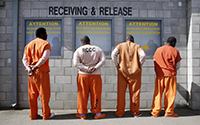Proven programs like high-quality early care and education and the Nurse-Family Partnership can help buffer the effects of poverty. But if we really want to improve life prospects for poor kids we need to reduce the number of poor kids. Which means increasing their families’ incomes.
There are many ideas for doing just that. While economic growth has disproportionately benefited high income groups while leaving low-income households behind, here are nine proposals to improve opportunity structures and increase the incomes of poor people already in play:
-
Increase employment
 There’s a lot of work to be done in the U.S. but much of it won’t generate a profit. That’s where government can step in. Investments in infrastructure—fixing old bridges, building mass transit, converting to clean energy sources—and investments in vital services such as schools, childcare and elder care generate both public benefits and jobs. So do local-hiring ordinances for large employers in low-income communities. Building low-cost housing provides jobs as it increases disposable income by lowering housing costs. Free community college could train more people. And if you believe anyone willing to work should have a job, then government can be the employer of last resort.
There’s a lot of work to be done in the U.S. but much of it won’t generate a profit. That’s where government can step in. Investments in infrastructure—fixing old bridges, building mass transit, converting to clean energy sources—and investments in vital services such as schools, childcare and elder care generate both public benefits and jobs. So do local-hiring ordinances for large employers in low-income communities. Building low-cost housing provides jobs as it increases disposable income by lowering housing costs. Free community college could train more people. And if you believe anyone willing to work should have a job, then government can be the employer of last resort.
-
Raise America’s pay
 The 2015 federal minimum wage of $7.25 / hour comes to $15,080 annually for full time work, 52 weeks a year. The federal poverty threshold for a family of three is $20,090 (and try living on that!). If the minimum wage were increased to $10.10/hour (lower in real dollars, btw, than the minimum wage of 1968), 20% of America’s children would benefit. Cities and some states are taking the lead raising the minimum wage to a living wage. Many studies suggest that strengthening unions and collective bargaining rights would also bring upward pressure on wages across the board.
The 2015 federal minimum wage of $7.25 / hour comes to $15,080 annually for full time work, 52 weeks a year. The federal poverty threshold for a family of three is $20,090 (and try living on that!). If the minimum wage were increased to $10.10/hour (lower in real dollars, btw, than the minimum wage of 1968), 20% of America’s children would benefit. Cities and some states are taking the lead raising the minimum wage to a living wage. Many studies suggest that strengthening unions and collective bargaining rights would also bring upward pressure on wages across the board.
-
Sustain not cut the social safety net
 Strengthening existing programs like unemployment insurance, food stamps (SNAP), cash assistance, and the earned income tax credit (EITC), along with new initiatives like child allowances and a guaranteed income, can raise household income and protect children.
Strengthening existing programs like unemployment insurance, food stamps (SNAP), cash assistance, and the earned income tax credit (EITC), along with new initiatives like child allowances and a guaranteed income, can raise household income and protect children.
-
Paid family and sick leave
 Leave would protect parents who take time off to care for their new baby, a sick child or family member from falling into poverty.
Leave would protect parents who take time off to care for their new baby, a sick child or family member from falling into poverty.
-
End mass incarceration
 The U.S. holds almost one quarter of the world’s prisoners. The war on drugs and police targeting of young black and brown men have wreaked special havoc on African American and Latino families, removing fathers from the workforce and their children. Many employers refuse to hire people with even minor criminal records, and many parolees are locked out of credit, housing, even education.
The U.S. holds almost one quarter of the world’s prisoners. The war on drugs and police targeting of young black and brown men have wreaked special havoc on African American and Latino families, removing fathers from the workforce and their children. Many employers refuse to hire people with even minor criminal records, and many parolees are locked out of credit, housing, even education.
-
Invest in high quality childcare and early ed
 Many parents must spend a significant chunk of their income on childcare, or can’t work because they can’t find quality childcare that’s affordable. Center-based care now averages more than $10,000 a year. Head Start (ages 3 – 5) funding enables it to serve only 42% of eligible families, while Early Head Start (birth to 3) serves less than 5%. Many studies illustrate that high quality childcare and ed helps low-income children build the foundation for skills that enable better education, jobs and earnings.
Many parents must spend a significant chunk of their income on childcare, or can’t work because they can’t find quality childcare that’s affordable. Center-based care now averages more than $10,000 a year. Head Start (ages 3 – 5) funding enables it to serve only 42% of eligible families, while Early Head Start (birth to 3) serves less than 5%. Many studies illustrate that high quality childcare and ed helps low-income children build the foundation for skills that enable better education, jobs and earnings.
-
Tackle segregation and concentrated poverty
 Structural racism has placed an even greater burden on black and Latino children, particularly low income children, shuttling them to isolated, resource-poor, and excluded poor communities. Housing vouchers along with re-zoning enabling scattered site low-income housing would reduce segregation and concentrated poverty and give poor children of color better access to resources, schools and social capital they can use to get ahead.
Structural racism has placed an even greater burden on black and Latino children, particularly low income children, shuttling them to isolated, resource-poor, and excluded poor communities. Housing vouchers along with re-zoning enabling scattered site low-income housing would reduce segregation and concentrated poverty and give poor children of color better access to resources, schools and social capital they can use to get ahead.
-
Immigration reform
 Undocumented workers face limited employment options and are easily exploited by employers. Their families are thus more likely to be poor. Children also live with the ever-present fear and anxiety that their parents may be arrested and deported at any moment – and are injured by trauma when they are.
Undocumented workers face limited employment options and are easily exploited by employers. Their families are thus more likely to be poor. Children also live with the ever-present fear and anxiety that their parents may be arrested and deported at any moment – and are injured by trauma when they are.
-
End the poverty tax
 People living in low-income neighborhoods pay extra for most everything, from food to car loans, and are dependent upon high-interest “pay-day loans” because many banks won’t serve poor neighborhoods. Nor can poor people afford to save money by purchasing in bulk. And without access to capital, low-income people can’t save enough to invest in their education or job training.
People living in low-income neighborhoods pay extra for most everything, from food to car loans, and are dependent upon high-interest “pay-day loans” because many banks won’t serve poor neighborhoods. Nor can poor people afford to save money by purchasing in bulk. And without access to capital, low-income people can’t save enough to invest in their education or job training.
Ultimately change depends on political power and the democratization of decision-making. Who has it, who uses it, how do low-income groups and their allies get it?